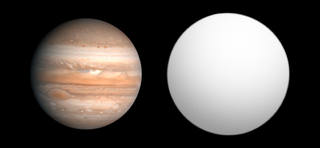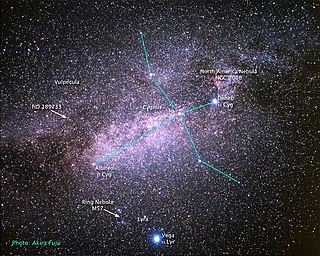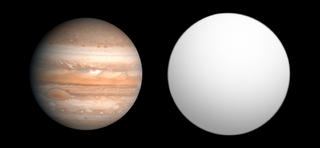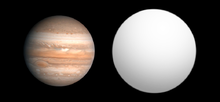
HD 209458 b is an exoplanet that orbits the solar analog HD 209458 in the constellation Pegasus, some 157 light-years from the Solar System. The radius of the planet's orbit is 0.047 AU, or one-eighth the radius of Mercury's orbit. This small radius results in a year that is 3.5 Earth-days long and an estimated surface temperature of about 1,000 °C. Its mass is 220 times that of Earth and its volume is some 2.5 times greater than that of Jupiter. The high mass and volume of HD 209458 b indicate that it is a gas giant.

HD 209458 is an 8th-magnitude star in the constellation Pegasus. It is a G0V star, and is thus very similar to the Sun. Because it is located at a distance of 157 light-years, it is not visible to the unaided eye. With good binoculars or a small telescope it should be easily detectable.

TrES-1b is an extrasolar planet approximately 523 light-years away in the constellation of Lyra. The planet's mass and radius indicate that it is a Jovian planet with a similar bulk composition to Jupiter. Unlike Jupiter, but similar to many other planets detected around other stars, TrES-1 is located very close to its star, and belongs to the class of planets known as hot Jupiters. The planet was discovered orbiting around GSC 02652-01324.

HD 149026 b, formally named Smertrios, is an extrasolar planet and hot Jupiter approximately 250 light-years from the Sun in the constellation of Hercules.

An exomoon or extrasolar moon is a natural satellite that orbits an exoplanet or other non-stellar extrasolar body.

HD 189733, also catalogued as V452 Vulpeculae, is a binary star system approximately 64.5 light-years away in the constellation of Vulpecula. The primary star is suspected to be an orange dwarf star, while the secondary star is a red dwarf star. Given that this system has the same visual magnitude as HD 209458, it promises much for the study of close transiting extrasolar planets. The star can be found with binoculars 0.3 degrees east of the Dumbbell Nebula (M27).

XO-1 is a magnitude 11 G-type main-sequence star located approximately 530 light-years away in the constellation Corona Borealis. XO-1 has a mass and radius similar to the Sun. In 2006 the extrasolar planet XO-1b was discovered orbiting XO-1 by the transit method using the XO Telescope.

Upsilon Andromedae b, formally named Saffar, is an extrasolar planet approximately 44 light-years away from the Sun in the constellation of Andromeda. The planet orbits the solar analog star, Upsilon Andromedae A, approximately every five days. Discovered in June 1996 by Geoffrey Marcy and R. Paul Butler, it was one of the first hot Jupiters to be discovered. It is also one of the first non-resolved planets to be detected directly. Upsilon Andromedae b is the innermost-known planet in its planetary system.

Upsilon Andromedae c, formally named Samh, is an extrasolar planet orbiting the Sun-like star Upsilon Andromedae A every 241.3 days at an average distance of 0.83 AU. Its discovery in April 1999 by Geoffrey Marcy and R. Paul Butler made this the first multiple-planet system to be discovered around a main-sequence star, and the first multiple-planet system known in a multiple star system. Upsilon Andromedae c is the second-known planet in order of distance from its star.

HAT-P-1b is an extrasolar planet orbiting the Sun-like star HAT-P-1, also known as ADS 16402 B. HAT-P-1 is the dimmer component of the ADS 16402 binary star system. It is located roughly 521 light years away from Earth in the constellation Lacerta. HAT-P-1b is among the least dense of any of the known extrasolar planets.

Any planet is an extremely faint light source compared to its parent star. For example, a star like the Sun is about a billion times as bright as the reflected light from any of the planets orbiting it. In addition to the intrinsic difficulty of detecting such a faint light source, the light from the parent star causes a glare that washes it out. For those reasons, very few of the exoplanets reported as of April 2014 have been observed directly, with even fewer being resolved from their host star.

XO-3b is an exoplanet with about 11.79 times the mass of Jupiter, and it orbits its parent star in about 3.2 days. The radius of this object is 1.217 times that of Jupiter. Astronomers announced their discovery on May 30, 2007, at the American Astronomical Society in Honolulu, Hawaii. Its discovery is attributed to the combined effort of amateur and professional astronomers working together on the XO Project using a telescope located on the Haleakala summit in Hawaii.
The XO Project is an international team of amateur and professional astronomers tasked with identifying extrasolar planets. They are led by Peter R. McCullough of the Space Telescope Science Institute. It is primarily funded by NASA's Origins Program and the Director's Discretionary Fund of the Space Telescope Science Institute.

HD 189733 b is an exoplanet in the constellation of Vulpecula approximately 64.5 light-years (19.8 pc) away from our Solar System. Astronomers in France discovered the planet orbiting the star HD 189733 on October 5, 2005, by observing its transit across the star's face. With a mass 16.2% higher than that of Jupiter and a radius 13.8% greater, HD 189733 b orbits its host star once every 2.2 days at an orbital speed of 152.5 kilometers per second, making it a hot Jupiter with poor prospects for extraterrestrial life.

WASP-12b is a hot Jupiter orbiting the star WASP-12, discovered on April 1, 2008, by the SuperWASP planetary transit survey. The planet takes only a little over one Earth day to orbit its star, in contrast to about 365.25 days for the Earth to orbit the Sun. Its distance from the star is only the Earth's distance from the Sun, with an eccentricity the same as Jupiter's. Consequently, it has one of the lowest densities for exoplanets. On December 3, 2013, scientists working with the Hubble Space Telescope (HST) reported detecting water in the atmosphere of the exoplanet. In July 2014, NASA announced finding very dry atmospheres on three exoplanets orbiting sun-like stars.
XO-5 is a yellow dwarf main sequence star located approximately 910 light-years away from Earth in the Lynx constellation. It has a magnitude of about 12 and cannot be seen with the naked eye but is visible through a small telescope.

XO-4b is an extrasolar planet approximately 956 light years away in the constellation of Lynx. This planet was found by the transit method by McCullough in May 2008. The planet has mass 1.72 MJ and radius 1.34 RJ. This planet orbits very close to the F-type parent star, as it is typical for transiting planets, classing this planet as Hot Jupiter.

XO-5b "Makropulos" is an extrasolar planet approximately 910 light years away in the constellation of Lynx. This planet was found by the transit method using the XO Telescope and announced in May 2008. It was also independently discovered by the HATNet Project. The planet has a mass and radius just slightly larger than that of Jupiter. This planet orbits very close to the G-type parent star, as it is typical for transiting planets, classing this as Hot Jupiter. It takes only 4.188 days to orbit at an orbital distance of 0.0488 AU).

An exoplanet is a planet located outside the Solar System. The first evidence of an exoplanet was noted as early as 1917, but was not recognized as such until 2016; no planet discovery has yet come from that evidence. What turned out to be the first detection of an exoplanet was published among a list of possible candidates in 1988, though not confirmed until 2003. The first confirmed detection came in 1992, with the discovery of terrestrial-mass planets orbiting the pulsar PSR B1257+12. The first confirmation of an exoplanet orbiting a main-sequence star was made in 1995, when a giant planet was found in a four-day orbit around the nearby star 51 Pegasi. Some exoplanets have been imaged directly by telescopes, but the vast majority have been detected through indirect methods, such as the transit method and the radial-velocity method. As of 1 August 2023, there are 5,484 confirmed exoplanets in 4,047 planetary systems, with 875 systems having more than one planet. This is a list of the most notable discoveries.

XO-6b is a transiting exoplanet, a hot Jupiter, orbiting the star XO-6 around 760 Light Years away from Earth. It was discovered in 2016 by the XO planet search team.



















